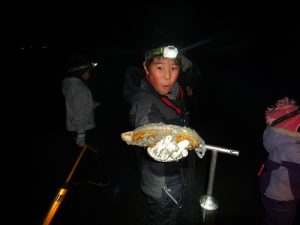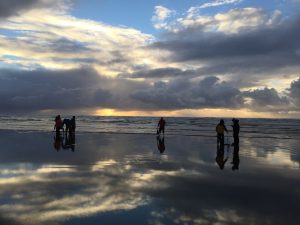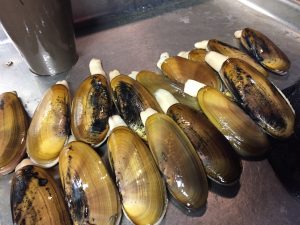Upcoming razor clam digs Oct. 6-7 on hold with more marine toxin testing necessary Leave a reply
By Mark Yuasa
Those making plans to hit the coast for razor clams Oct. 6-7 will have to hit the pause button until early next week when a final, final decision will come to light.
“I did have a conference call with state health (on Wednesday morning), and they have some concerns based on most recent test results and also data coming from (National Oceanic and Atmospheric Administration) for harmful algae blooms offshore,” said Dan Ayres, the head state Fish and Wildlife coastal shellfish manager.
Ayres said state health has requested them to take another sample of clams from the four beaches this coming Monday (Oct. 2), and then get word out by late Tuesday on those results and if they can proceed with the digs.
The latest toxin testing this past Monday showed marine toxin levels for domoic acid were still below the cutoff threshold.
Once cleared the digs are Oct. 6 (a minus-0.4 feet low tide at 7:49 p.m.) and Oct. 7 (-0.7 at 8:33 p.m.) at Long Beach, Twin Harbors, Copalis and Mocrocks.
On the positive side, Ayres noted his samplers found clams all over two northern beaches especially Mocrocks although there are small, little guys mixed in. Some of those smaller clams are growing into the fishery, and will get bigger in time for the spring digs.
“The (summer) stock assessment gives us numbers (which appeared down from past years), but it doesn’t give an overall sense of what is there,” Ayres said. “We didn’t have any problem getting clams during our assessments in particular at Mocrocks and Copalis.”
The news might not be so rosy for those heading to the southern coast where places like Long Beach lost of lot of clams where feed was sparse and the salinity level dropped due to all the freshwater runoff in the Columbia River. The clams leftover were not fat clams at Long Beach in the spring so they also might be on the slimmer size.

Ichiro Nakata of Mercer Island likes what he found in the sand during a night time dig at Copalis Beach.
Twin Harbors also saw a decline in the clam population, but to a slightly lesser degree.
Fall and winter razor clam digs occur during evening low tides while spring-time digs occur during morning low tides.
Dates have been set through Dec. 31, and as mentioned above each series hinges on marine toxin testing before opening.
Other dates planned are:
Nov. 2 (0.1 at 6:03 p.m.) at Copalis; Nov. 3 (-0.7 at 6:47 p.m.) on Long Beach, Twin Harbors and Mocrocks; Nov. 4 (-1.2 at 7:31 p.m.) on Long Beach, Twin Harbors and Copalis; and Nov. 5 (-1.4 at 7:16 p.m.) on Long Beach, Twin Harbors and Mocrocks.
Dec. 1 (-0.3 at 4:42 p.m.) at Copalis; Dec. 2 (-1.1 at 5:29 p.m.) on Long Beach, Twin Harbors and Mocrocks; Dec. 3 (-1.6 at 6:15 p.m.) on Long Beach, Twin Harbors and Copalis; Dec. 4 (-1.8 at 7:02 p.m.) on Long Beach, Twin Harbors and Mocrocks; and Dec. 31 (1.2 at 5:12 p.m.) on Long Beach, Twin Harbors, Copalis and Mocrocks.
For more information, go to http://wdfw.wa.gov/fishing/shellfish/razorclams/.
Oregon reopens for razor clams
If you want to get a head start, just cross the Columbia River to Oregon’s Clatsop County beaches, which reopens this Sunday (Oct. 1) after being closed since July of 2016, the Oregon Department of Fish and Wildlife reported.
The closure was necessary due to elevated levels of marine toxins and a closure to protect newly set young clams from July 15 through Sept. 30 that occurs yearly.
Other Oregon beaches have remained open for razor clam digging, but Clatsop County beaches are the most popular spot and make up 90 percent of state’s harvest.
Oregon beaches are tested twice a month to ensure clams and other shellfish are safe for human consumption.
Ayres noted the most recent tests taken Sept. 8 and Sept. 22 at Clatsop County beaches showed levels at 19 parts per million (ppm), which is a hair under the 20 ppm cutoff.
During the summer of 2016, diggers found a bounty of clams during a record year with the majority of diggers attaining their 15-clam daily limit.
When the beaches reopen it is likely that diggers will find a different scenario since surveys found abundance levels significantly lower since surveys began in 2004.
“In 2016, abundance peaked and surveys estimated 16 million razor clams in the 18-mile stretch between the Columbia River south jetty and Tillamook Head,” Matt Hunter, the ODFW’s Lead Shellfish Manager said in a news release. “This year, the estimate is just 3 million clams in that area.”
“These low numbers are troubling, as they mean Clatsop beaches haven’t seen a significant recruitment event for two years,” Hunter said. “But this recruitment issue is not isolated to just Clatsop beaches. It’s being seen on the entire Oregon coast and for Washington beaches, too.”
While total numbers are down, diggers will find larger-sized clams averaging about 4 ½ inches with only a few clams smaller than 4-inches. Surveys showed clams distributed sporadically along the entire stretch of the beach.
“While razor clam numbers are lower this year, clams are quite large,” Hunter said. “To be successful, clammers should be diligent, choose the best low tides and actively ‘pound’ to get razors to show.”
The daily limit is the first 15 clams dug regardless of size or condition, and sorting or releasing clams isn’t allowed.
Shellfish testing is conducted twice per month. Before going call 800-448-2474 or go to http://www.oregon.gov/ODA/programs/FoodSafety/Shellfish/Pages/ShellfishClosures.aspx.
Mark Yuasa
Outdoor Line Blogger
710 ESPN Seattle




